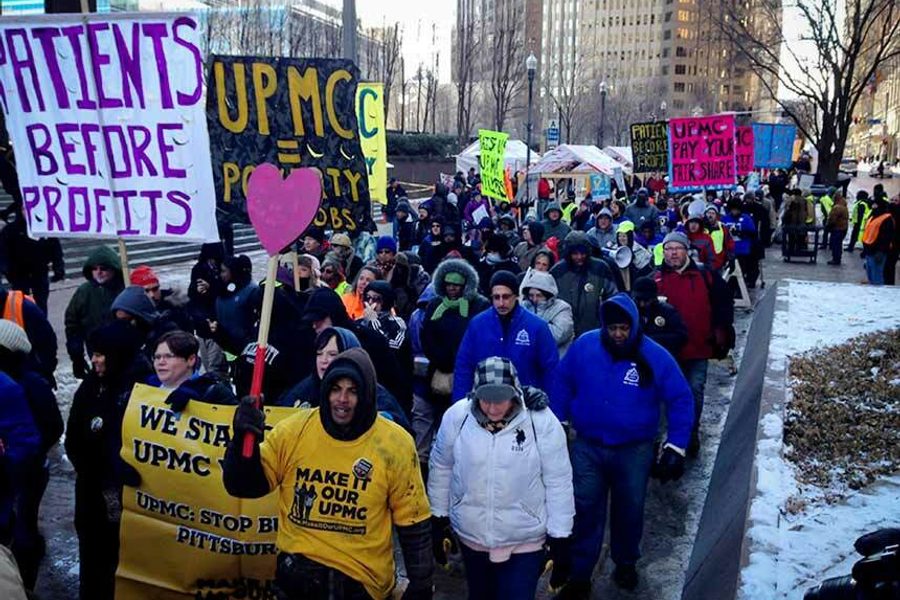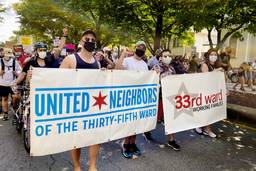Pittsburgh’s Nonprofit Pirates
A hospital behemoth dominates the city, pays no taxes and does little for its lowest-paid workers.
Rebecca Burns

On a frigid day in Pittsburgh this March, more than 1,000 protesters blocked the streets outside the iconic U.S. Steel Tower. Following dramatic downsizing in the steel industry, this building, which was once a symbol of the Rust Belt city’s preeminence in manufacturing, was repurposed in 2007 as the headquarters of the University of Pittsburgh Medical Center (UPMC), epitomizing the way healthcare has replaced manufacturing as the region’s economic engine. Today, UPMC is Pittsburgh’s largest employer, and the target of a vigorous unionization effort by the Service Employees International Union (SEIU).
The UPMC campaign has taken on a symbolic importance in Steeltown: Just as labor battles at the city’s steel mills during the 20th century helped raise wages and build the country’s nascent industrial unions, the SEIU and its allies are hoping that a victory at UPMC could again have a ripple effect on wages and union power.
The effort also has national significance: Given UPMC’s status as the nation’s top-grossing nonprofit hospital, the campaign has become a staging ground for a host of thorny labor and political issues related to the proliferation of tax-exempt healthcare institutions. Nonprofits are the fastest-growing sector in the U.S. economy, with healthcare and education providers driving the boom. Nonprofit clinics and charter schools often replace troubled public- sector institutions, forming what has been called a “shadow state” in the hull of the welfare state and — in a trend that has potentially profound implications for labor—replacing a highly unionized public-sector workforce with a typically non-union private one. Meanwhile, nonprofit hospitals have also been the subject of a fierce national debate over the merit of their tax exemptions, given the impact on city coffers and the sometimes paltry charitable services provided in return.
The protests on March 3 and 4 were probably “the biggest Pittsburgh has had in 20 years,” says UPMC cafeteria worker Christoria Hughes, who’s been active in the union drive since it began two years ago. Hughes, 57, has worked in food service at UPMC for six years and worries that her hourly wage of $12.75 will never allow her to save enough for retirement. Hughes and other UPMC workers are calling for a $15 wage, the right to form a union and the elimination of their medical debt. UPMC operates its own health insurance plan, and workers who purchase it typically pay premiums of more than $2,200 for individuals, according to a report from the nonprofit Pittsburgh United.
“It’s like having to buy health insurance from the company store,” says Hughes.
In response to the protests, UPMC spokesperson Paul Wood said in a statement, “We take very seriously our role as a leading employer and are proud of the compensation that we offer. We choose to pay our service workers in Pittsburgh at higher wages than the local market average, with our average service workers earning $12.81 per hour.”
Joining Hughes and other UPMC workers at the protests were scores of members from other unions and community groups. Faced with stiff employer resistance to its organizing drive, SEIU has reached out to community organizations for support — a tactic that quickly struck a chord in Pittsburgh, given UPMC’s outsize influence and negative reputation. Beyond its labor practices, faith and community organizations have lambasted UPMC for closing hospitals in the city’s neediest neighborhoods. Last year, these groups banded together to launch “Make it Our UPMC,” a campaign combining a traditional union drive with a community-driven call for the medical center to do more for its workers, patients and the city at large.
UPMC exemplifies many of the most controversial aspects of large nonprofit hospitals, which critics say are practically indiscernible from for-profits in their operations. The medical center holds $4 billion in reserve and has reaped another $1.3 billion in profits over the past three years. Meanwhile, healthcare consultants estimate that UPMC has spent $96 million, or 2 percent of its operating budget, on the provision of free healthcare. UPMC does not differentiate between free and reduced-cost healthcare in its own estimate, putting this figure at $200 million. Few national standards exist to regulate the “charity care and community benefits” that nonprofit hospitals provide in exchange for tax breaks. Several state-level studies have found that the value of the tax breaks provided by nonprofit hospitals far exceeds the estimated value of the community benefits they provide. Nationwide, nonprofit hospitals enjoy some $12 billion to $20 billion in exemptions from federal, state and local taxes annually.
Last year, the City of Pittsburgh filed a lawsuit challenging UPMC’S nonprofit status and seeking payment of an estimated $20 million in property and payroll taxes annually. The lawsuit was introduced by outgoing Mayor Luke Ravenstahl, but new Mayor Bill Peduto, who won office last year on a progressive, pro-labor platform, has said that he intends to carry it forward. Though not a party to the city’s lawsuit, Make It Our UPMC supports it, contending that if the medical center paid taxes, it would lead to $14 million in additional revenue for Pittsburgh Public Schools— a consideration that drew the Pittsburgh Federation of Teachers to the campaign.
UPMC and some 40 other large nonprofits in the city do make voluntary annual contributions to the Pittsburgh Public Service Fund, but the amount each organization contributes is not disclosed. In 2012, the Fund bequeathed a grand total of $2.6 million to the city. Since the contract between the city and the nonprofits expired last year, Peduto has sought to renegotiate more funding fixed over longer periods so that the city isn’t left “begging” for contributions each year. Given that the city’s growth is being driven by tax-exempt hospitals and universities, “There’s a disconnect between how our economy is being run and how our government is being financed,” Peduto’s chief of staff told the Pittsburgh City Paper in March.
After two days of protest in front of UPMC headquarters, the crowd disbanded at the request of Peduto, who told the organizations involved that he would seek to mediate the dispute with UPMC. Following a March 5 meeting with the UPMC CEO, Peduto told reporters that progress had been made, though issues hadn’t been resolved.
Workers are also awaiting the results of a National Labor Relations Board trial against UPMC that began earlier this year after the NLRB issued a complaint, based on interviews with workers and the SEIU, that UPMC illegally fired, harassed and intimidated pro- union employees.
Hughes says support from the community and the mayor’s office has given their campaign a boost, but that workers still have a long way to go, given UPMC’s power in the region. “It’s going to be an ongoing battle,” she says. “But I’m in it for the long haul.”
Rebecca Burns is an In These Times contributing editor and award-winning investigative reporter. Her work has appeared in Bloomberg, the Chicago Reader, ProPublica, The Intercept, and USA Today. Follow her on Twitter @rejburns.









